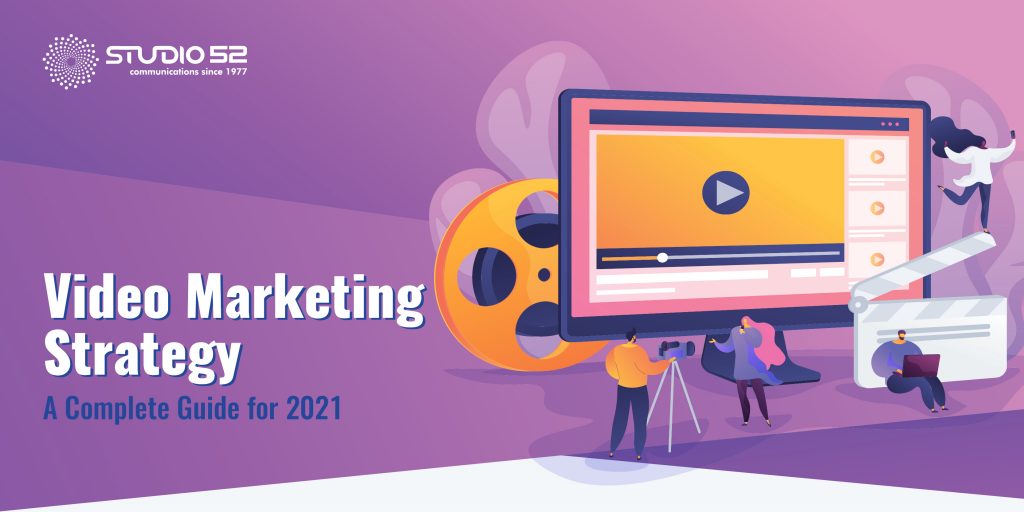By now, you probably already know the power of video. As competition for market share grows in nearly every industry, video is the quickest and most effective medium to connect with your audience. What’s more, according to a report by Cisco, by the year 2022, video content will form 82% of Internet traffic.
So how do you create captivating visual content that attracts, engages, and retains your audience? In this post, we are going to equip you to do just that. We are going to cover:
- Video Marketing: A Short History
- Video Marketing: What is the Current Trend?
- Video Marketing: Why Should You Embrace it?
- Video Marketing: How to Get Started?
- Video Marketing: What Kind of Video Should I Create?
- Video Marketing: What are the Different Styles?
- Video Marketing: How Do You Produce the Video?
- Video Marketing: How Do I Distribute My Video?
- Video Marketing: How Do I Know If My Video is Successful?
So first, let’s cover the basics of video marketing.
-
Video Marketing: A Short History
Video marketing has become a vital part of our daily lives whether we are simply consumers or creators. But, that doesn’t mean it didn’t exist before. Video marketing has been around since 1941, when the first TV ad aired during a Brooklyn Dodgers and Philadelphia Phillies game, promoting a wristwatch to baseball fans. Soon came the internet age that catapulted video marketing from a television affair to your computer – and eventually to your smartphone and tablet.
It’s impossible to discuss video marketing without first mentioning YouTube. In February 2005, YouTube launched, and seven months later, the channel’s first viral video – a Nike ad – hit one million views. Today, more than one billion hours of video are watched daily on the platform. Facebook videos have 8 billion views per day and 11% of all the content uploaded is video.
Also Read- What Is A Business Growth Consultant And Why Hire One?
-
Video Marketing: What is the Current Trend?
Various statistics have pointed out that video is the future of marketing. Therefore to meet this growing demand, Facebook, Instagram, Twitter, and LinkedIn have all created new video-friendly features like ‘live’ broadcasting, and ‘stories’. At the same time, the popularity of video-based platforms like YouTube, Snapchat, and Tik Tok has exploded. These developments mean that people are spending more time watching a video and creating these videos has become far easier than before.
-
Video Marketing: Why Should You Embrace it?
As you can see the number of videos being watched every day is on a constant rise from the time it all started. But, what’s their impact? If you look at these stats below, you can see the benefits of video marketing in numbers:
- 83% of video marketers say video has helped increase the average time their visitors spend on-page.
- 94% of video marketers say video has helped increase user understanding of their product or service.
- 84% of video marketers say video has helped them generate leads.
- 78% of video marketers say video has directly helped increase sales.
- 84% of people say that they’ve been convinced to buy a product or service by watching a brand’s video.
- Marketers who use video grow revenue 49% faster than non-video users.
- The chances of a website ranking on the front page of Google increases by 53 times if the URL has a video embedded in it.
Based on the numbers above, the need for a brand to embrace video is clear. But the digital space is getting crowded as more and more videos are made available online.
-
Video Marketing: How to Get Started?
If you have read all the stats and points above, you would notice that video marketing is now expected by customers. This means you don’t have a choice. It’s now a necessity for any business that wants to make its mark.
So, let’s see how you can get started with video marketing.
4.1 Understand Your Audience
Before diving into the nitty-gritty of planning, it is important to first establish who would be watching your videos. For example, if your product or service is aimed towards a woman, then the style of video you need to make would be very different from the product aimed at teens. This is why it’s very important to have a clear idea of who your target audience is.
For that, you can refer to your company’s buyer’s persona. With your buyer’s persona mapped out, you would know who your target audience is.
4.2 Set a Goal
The next important thing you need to do is figure out what you want to accomplish with the video. Are you trying to drive awareness, sales, traffic, or all of these? It could also be that you are trying to create better brand recognition with your video. Whatever may be the reason, it’s best to set a clear goal before putting your video marketing strategy into action. This way you will stay focused and also have a point of reference by which you can measure your strategy’s success.
-
Video Marketing: What Kind of Video Should I Create?
Once you have your strategy in place, it’s time to think about the actual video you’re going to create. Whatever type or style of video you choose, it would have its own pros and cons. So, it’s best to choose the one that works well with your specific marketing goals.
Here’s a breakdown of some of the most common types and styles of video, so you can get the video creation process started!
5.1 Advertisements
Advertisements are brief, attention-grabbing videos that highlight your company’s best features. They’re the most common type of video; you most likely would have watched a number of them yourself on TV, or YouTube. The primary goal of these video ads is to attract new customers, which is why they often provide only the most important and relevant information a viewer might need.
Ads are usually distributed via paid advertising online or on television and are usually not more than 30 seconds to one minute.
5.2 Social Media Videos
Short video clips created solely for social media platforms like Facebook, Instagram, Twitter, LinkedIn, and more are called social media videos. These videos are usually fun, playful, engaging, and designed to be shared. Due to their fun, engaging nature and shorter length, they most often help engage potential and current customers.
For social media videos, it’s essential that you pay attention to aspects unique to social media, such as muted autoplay, and video looping.
5.3 Explainer Videos
Explainer videos are one of the biggest categories of online video content. They’re a versatile format that can be used to explain anything from how your service or product works, to an explanation of a concept, or how to do something.
The goal of most explainers about a business or service is ‘conversion’. These are most often embedded in a landing or homepage, or emailed to prospects. They can also be run on social media with the same goal.
5.4 Product Videos
A product video tells your audience about the top features of your products or services. It shows your product in action and shows the viewers how it solves problems. These videos are usually about 30 seconds long and can be shared through paid advertising, social media platforms, or email.
5.5 Testimonials
Testimonial videos are one of the strongest types of videos you can make. It leverages your existing customer base to prove that you are worth trusting as a company. According to a recent survey, 90% of consumers say that their buying decisions are influenced by online reviews. So, it would be a great idea to include these reviews in your marketing funnel to improve your brand credibility.
-
Video Marketing: What are the Different Styles?
There’s a range of different styles of video you can use – from live-action to animation, there’s something for everyone! But choosing the right video style isn’t always easy. Here are some video styles that you can try:
6.1 Live Video
Live videos are an effective way to deeply engage your audience. They offer audiences a unique way to interact in real-time, giving them a greater opportunity to build a relationship. Live content can also be used after you have finished broadcasting, meaning that you can repost it and share it with future audiences.
6.2. Lifestyle
A lifestyle video is any video that appeals directly to your target demographic, helping them visualize how your product or service fits into their way of life. Beautiful visuals, action shots, and stunning imagery are used to set the mood and the lifestyle you want to associate with your product.
6.3 Mini-documentaries
Mini-documentaries are less about your brand’s visual aesthetics and focus more on expressing your company’s core value or mission statement in a documentary-style format. Such videos would usually include interviews with key company representatives, like founders, employees, or satisfied customers.
6.4 Narrative
Narrative style videos are probably the most common styles of video besides animation. They use classic storytelling elements, including character building, conflict, and resolution, to tell your brand story in an entertaining and engaging way. They create a journey that your viewer can easily follow and relate to.
6.4 Animation
Animation is made from a series of still images, which when played one after another, give you the illusion of movement. These moving pictures tell a story you want to convey. The style is great when you want to show something new. For instance, it’s much easier to animate a character or a sci-fi setting than to recreate them in the real world. This is why you should not miss animation.
-
Video Marketing: How Do You Produce the Video?
Now you’re ready for the most fun stage of video marketing. Your video strategy is set, you know what your video goals are, and you have decided upon the type and style of video that’ll help you get there. It’s time to get creative!
You need to write the script for the video, search for the perfect video production agency, get the video created, and finally celebrate a beautiful, well-crafted video you can be proud of.
With the right partner the entire production process should not take long, but be sure to plan more time than you need so you don’t fall behind with your video marketing campaign. If you are working with a professional video production service, you wouldn’t have to worry about these. For instance, at Studio52 we work with the client every step of the way, we brainstorm, research, plan, conceptualize, develop a creative script, produce, arrange for a film permit if needed, put the video together and finally deliver it to your doorstep. So it might help to bring in an agency at this stage to handle all these technical details.
-
Video Marketing: How Do I Distribute My Video?
Your video is finally ready, now what? How do you actually get it to the people? How do you make them share it? This is where distribution comes in. It’s essential that your video is distributed on the right channels for your video’s success.
There are many ways you can distribute your videos such as owned, paid, and earned distribution channels. Each has its own pros and cons, therefore it’s best to use the right balance of them all to push your video to the viewers.
From all the video marketing stats given above, it’s already clear that people like videos, so use them to your advantage. You can post the video on your social media platforms, include them in emails, blog posts, and landing pages. The more engaging your videos are, the better!
Apart from getting views, you can also use videos to help boost your SEO. It has been shown to improve click-through rates and engage viewers on your website for longer. Both of these are important elements for SEO and can improve your website ranking on search engines.
-
Video Marketing: How Do I Know If My Video is Successful?
It all depends upon where you host your videos. Depending upon the platform you expose your video on, you can track the results and find out if your video is successful or not. These days every platform has its own extensive metrics tool for all the details you might need. Make custom reports that focus on the metrics that matter the most to you.
Don’t stop what you are doing just because you didn’t see any results on day one. The key to success is analyzing, finding flaws, and then improving.
Now that you know about video marketing in detail, it’s time to take your marketing to the next level. Experiment and find the style that works for you. Regardless of the video marketing campaign you run, always stay true to your brand and its identity. If you do, you’ll generate great results and reap the benefits of video marketing!
Ready to create waves with your video marketing strategy for 2021 and beyond? Reach out to us today to get started.





